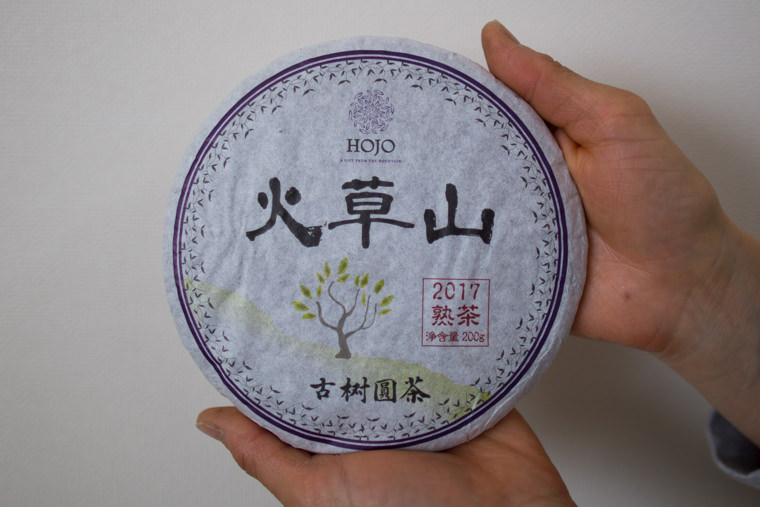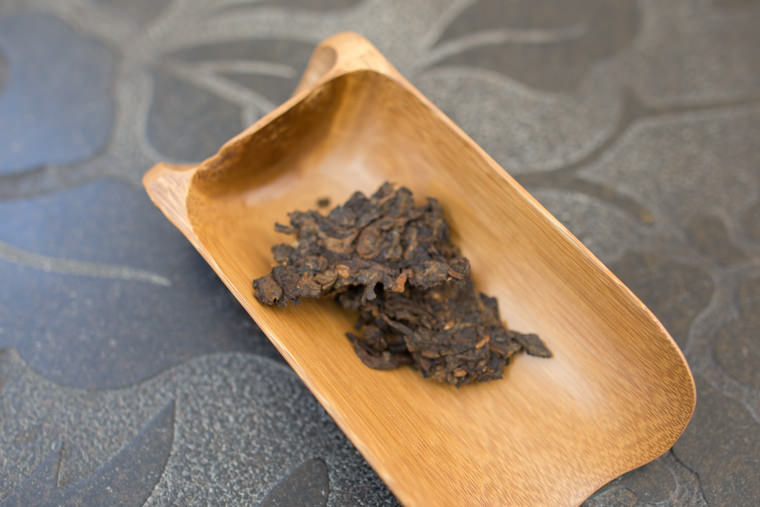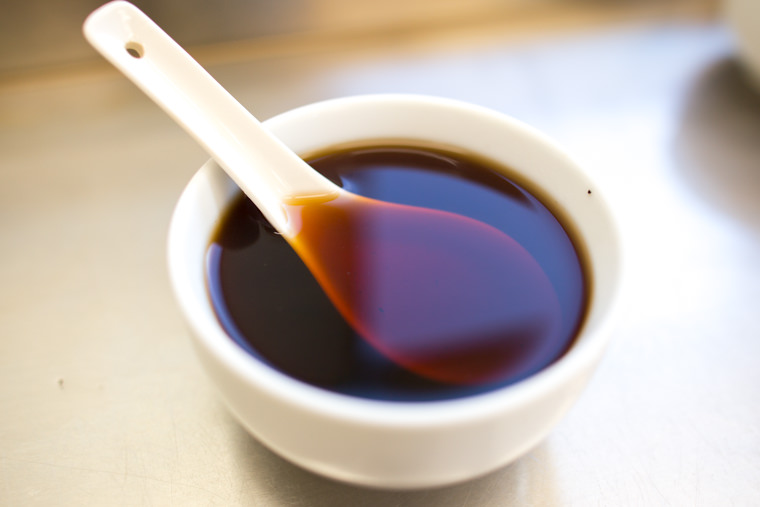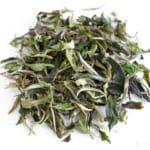- HOME >
- New Arrival at HOJO Online Shop
New release of Huo Cao Shan Ripe Pu-erh Tea 2017
- [2018.05.27] Posted By Akira Hojo
Using the spring tea collected from the garden that is left in wild for more than 30 years, we made Huo Cao Shan ripe pu-erh tea. It gives soft and silky mouth-feel with long-lasting aftertaste, with a hint of sweet flavour like dates or dried figs.
Huo Cao Shan is located near the Myanmar border
Huo Cao Shan is located in the south west of Lincang. It is situated in Zhenkang county facing to the national border of Myanmar. Next to Huo Cao Shan is Ma An Shan, one of the renowned mountain that produces excellent tea. The process of making this tea is not unique, but the material is very special. Because of Huo Cao Shan is located at far distance from the nearest airport (more than 8 hours), we found that a number of tea gardens are still kept in very traditional way. The tea gardens are left in wild, with no fertilizer, no pesticide or herbicide and most of the time, weeds are remained. The tea trees are surrounded with wild plants and it’s a well-balanced ecology.
It looks like bush. But actually, it is the tea garden that is left in wild.
Ripe pu-erh tea made of spring crop is very limited
The main market of ripe pu-erh tea is north-east of China or overseas. These are quite price sensitive market. Thus, most of the ripe pu-erh tea manufacturers are very particular about the cost of raw material. Normally, some manufacturers will blend three seasons tea in order to even out the cost and the quality. In most cases, the manufacturers only use two seasons tea (summer and autumn) for making ripe pu-erh tea. In the past two years, more and more manufacturers use only summer and autumn crop for making ripe pu-erh as the price of spring crop has increased a lot. Nowadays if we purchase tea from wholesalers in Kunming or Guangzhou, we can hardly get the ripe pu-erh tea made of 100% spring tea.
Nevertheless, if one has ever tasted spring tea, it is hard to come back to the summer or autumn tea. The taste and the flavour are obviously different. The spring tea taste is soft, mellow, rich, sweet and the after taste lasts for a long time.
The freshly produced raw pu-erh of Huo Cao Shan.
Custom-order ripe pu-erh tea
The ripe pu-erh tea is produced through the fermentation of raw pu-erh tea. The raw material of Huo Cao Shan ripe pu-erh tea gives an excellent drinking sensation even if we drink it before fermentation. It is essential to choose the quality material in order to produce quality ripe pu-erh tea. However, the fermentation of ripe pu-erh tea required several tonnes of raw pu-erh tea to be piled at one time, and the whole fermentation process takes about 45-60 days. It involved huge cost and high risk. We have been requesting our manufacturer to produce premium ripe pu-erh tea. But it was not very easy to convince them, especially recently the price of raw pu-erh has skyrocketed. Usually, the commercial tea markets are expecting low price ripe pu-erh tea and less demand for the high-end ripe pu-erh tea. Our manufacturer knew that it would not be easy for him to sell premium ripe pu-erh tea. However, after many rounds of discussion and persistent request, finally our manufacturer found the way to conduct fermentation in much smaller scale, and he managed to collect the raw pu-erh tea from Huo Cao Shan for making ripe pu-erh tea.
Appropriate material and process makes it excellent flavour
A number of customers told us that the reason they did not like ripe pu-erh tea is because of the particular smell that reminded them of old furniture or mold. In fact, this specific flavour is composed because of two reasons. Firstly, if moisture is too high and aeration is not sufficient during the fermentation, it promotes the growth of anaerobic bacteria. It produces musty or earthy smell. During piling process, tea has to be agitated regularly in order to supply adequate oxygen. Once the moisture and oxygen supply are adequate, the aerobic bacteria dominate the fermentation and increase the temperature of tea leaves. As a result, it supresses the growth of other unfavourable bacteria and eventually it produces sweet fruity flavour.
Another reason of the formation of unpleasant flavour is due to the raw material. As manufacturers are too particular about the cost, they often collect the low cost raw pu-erh tea directly from farmers at remote villages; these raw pu-erh teas often have extremely smoky flavour. After the fermentation, the smoky smell still remains as typical smoky and woodsy flavour of ripe pu-erh tea. Some people likes it but some people do not like it.
Huo Cao Shan ripe pu-erh tea gives very mellow drinking sensation with sweet Chinese dates flavour. As this tea is very rich in mineral, it will age well. I particularly recommend this tea for the customer who usually love raw pu-erh tea. This should be the tea that even raw pu-erh tea drinker could also enjoy.
Related Articles
How to get the latest update on HOJO?
1. Follow Twitter, 2. Click "Like" on Facebook, and 3. Subscribe in newsletter. You can have the latest tea news from HOJO.
 Subscribe the Newsletter to enjoy the privileges
Subscribe the Newsletter to enjoy the privileges- You may receive a free sample upon purchase, or you may have the priority to purchase special products. So please remember to subscribe our newsletter as well as the social network.
- Fresh 2025 Yunnan White Tea – Select Your Favourite Lot Before Blending
- Freshly crafted in Yunnan and just arrived in KL, our new 2025 white tea is now available at our Gardens Mall …
- 2024 Dong Shan Raw Pu-erh Tea – Crafted with the Producer for Desired Quality
- We have released the 2024 cake of Dong Shan Raw Pu-erh Tea. Earlier, we offered the loose-leaf version from th …
NEW ARTICLES
 Fresh 2025 Yunnan White Tea – Select Your Favourite Lot Before Blending
Fresh 2025 Yunnan White Tea – Select Your Favourite Lot Before Blending- Freshly crafted in Yunnan and just arrived in KL, our new 2025 white tea is now available at our Gardens Mall …
 2024 Dong Shan Raw Pu-erh Tea – Crafted with the Producer for Desired Quality
2024 Dong Shan Raw Pu-erh Tea – Crafted with the Producer for Desired Quality- We have released the 2024 cake of Dong Shan Raw Pu-erh Tea. Earlier, we offered the loose-leaf version from th …
 Development of Firewood Roasted Hojicha Using Naturally Grown Tea from Yunnan
Development of Firewood Roasted Hojicha Using Naturally Grown Tea from Yunnan- We are currently staying in Yunnan Province for tea production. As the season nears its end, tea trees with pa …
 Exploring the Food Culture of Yunnan: Where Minority and Sichuan Cuisines Meet
Exploring the Food Culture of Yunnan: Where Minority and Sichuan Cuisines Meet- We are currently staying long-term in Yunnan Province for spring tea production. On rainy days or when there i …
 New Arrival of Akitsu Mumyoi and Nosaka Rough Clay Teapot
New Arrival of Akitsu Mumyoi and Nosaka Rough Clay Teapot- A wide selection of teaware by Watanabe Tozo, a Sado-based artist of Mumyoi-yaki, has just arrived. This time, …
 Managing Yunnan White Tea — Insights from the Field
Managing Yunnan White Tea — Insights from the Field- Since March 25, we have been in Yunnan Province, fully engaged in the production of white tea. In this column, …
 Mang Fei Ripe Pu-erh Tea 2023 – Small-Batch Production from a Renowned Region
Mang Fei Ripe Pu-erh Tea 2023 – Small-Batch Production from a Renowned Region- Mang Fei Ripe Pu-erh Tea 2023 is now available. This is one of the highest-quality ripe pu-erh teas among our …
 Yunnan Tea Trends 2025: Insights from the Fields
Yunnan Tea Trends 2025: Insights from the Fields- Since March 25, we have been in Yunnan Province. We will stay here until May to conduct tea production, packin …
 Why Do Some Teas Taste Astringent? Exploring the Causes and Mechanisms of Astringency
Why Do Some Teas Taste Astringent? Exploring the Causes and Mechanisms of Astringency- Tea can range from having no noticeable astringency to possessing a very strong one. What causes this astringe …
 The Impact of Heat Sources on Tea Flavor
The Impact of Heat Sources on Tea Flavor- It is widely recognized that the material of a kettle plays an important role in shaping the taste of water fo …
Category
- New Arrival at HOJO Online Shop
- Featured Articles
- Newsletter
- Types of Tea
- Origin of Tea
- Teapot and Tea Equipment
- Tea Column
- How to enjoy tea
- Tea Processing
- How to choose quality tea
- Tea constituents and functional effect
- Safety of Tea
- Foods
- Tea Business Operation
- Hobby and Outdoor Activity
- Ranking of Tea
- Video
- FAQ
- Media Release
Profile

- AKIRA HOJO
- I invite you to experience my tea selections.I was born in Nagano, Japan. In university, I studied agricultural chemistry, and I have the master degree in food science. I worked in Japanese food industry for 10 years. I involved in R&D, QC and QA. As a factory manager, I implemented ISO9000 series and managed the factory.
- The Art of Tea Magazine
- We posted the article on “The Art of Tea Magazine No.9, the magazine is published in Taiwan. We featured …
- New Straits Times
- The Malaysian National Newspaper, New Straits Times featured HOJO Tea on 17-Oct-2007.
Shop Info

Address:Lot No. T-215, 3rd Floor, The Gardens Mall, Mid Valley City, Lingkaran Syed Putra, 59200 Kuala Lumpur
Tel: +603-2287-4537
Business Hour: 10am to 10pm





















